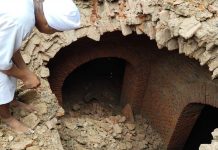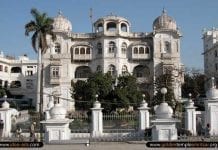

 NEW YORK, USA—On April 6, 1903, the city of Kishinev, the capital of the Russian province of Bessarabia erupted in violence. A horrific pogrom was organized, targeting the Jewish population of Kishinev. After three days of violence, 49 Jews were dead, 500 were wounded, 1300 homes and businesses were destroyed and 2000 families were left homeless.
NEW YORK, USA—On April 6, 1903, the city of Kishinev, the capital of the Russian province of Bessarabia erupted in violence. A horrific pogrom was organized, targeting the Jewish population of Kishinev. After three days of violence, 49 Jews were dead, 500 were wounded, 1300 homes and businesses were destroyed and 2000 families were left homeless.
The young Hebrew poet, Haim NahmanBialik went to Kishinev to talk to survivors and report on the pogrom. Bialik wrote one of his most famous poems, ‘In The City Of Slaughter’ in response to the Kishinev pogrom, using searing, powerful imagery to describe the horror that descended upon the Jewish residents of the city.
Eighty one years later, Delhi, the capital of the largest democracy in the world, India, was witness to a horror of even greater proportions. On October 31, 1984, Indira Gandhi, the Prime Minister of India was shot dead by her Sikh bodyguards. In retaliation, an orgy of murder, rape and arson was unleashed upon the Sikh residents of Delhi in which more than 3000 lost their lives.
The poem, ‘Kultar’s Mime,’ written by a young Sikh poet, drew upon eyewitness accounts of the Delhi pogrom to describe the sufferings of the Sikhs of Delhi, through the eyes of a group of young survivors.
There are uncanny similarities between the Kishinev and Delhi pogroms. Both targeted minority communities with violence following libel, innuendo and propaganda, designed to stoke fear and hatred.
Kultar’s Mime, the play, synthesizes the sufferings of innocent victims of organized violence, separated by thousands of miles, numerous years and insurmountable differences of religion, language and culture. Drawing upon the raw imagery of both poems, it tells a story of human suffering and courage, reminding us that in the end all innocent victims are the same, regardless of which God they worship and what tongues they speak.
The play is set in New York City. A collective of young Jewish artists, influenced by Bialik’s ‘In The City of Slaughter’ decides to commemorate the Kishinev Pogrom by organizing an art exhibition in which they intend to display paintings about the pogrom accompanied by a reading of the poem. As they get together and revisit Bialik’s poem, it occurs to them that it would be very powerful to honor the suffering of the innocent victims of Kishinev by shining the spotlight on other similar instances of organized violence that the world has largely forgotten. They decide to focus on the anti-Sikh pogrom of 1984 in Delhi and make it the subject of their exhibition, using words from the poem to augment the impact of the paintings they have created about the Delhi pogrom.
The Sikh Research Institute has partnered with Sarbpreet Singh and J.Mehr Kaur, the playwrights to produce ‘Kultar’s Mime,’ which will be staged in Boston in September 2014 and NYC, NJ, Ottawa and Toronto in October 2014. All performances will be open to the public and no admission will be charged. An ensemble cast of professional Boston area actors has been assembled and rehearsals have started.
What We Need & What You Get
We need your help to get the cast and crew to Delhi! You will get the satisfaction of knowing that your contribution has sent a group of young actors halfway across the world in an act of great compassion to tell the stories of young children who were brutalized thirty years ago. Strike a blow against the mindless violence that continues to be heaped on innocents all over the world by helping bring this story to life.
The Concept
Kultar’s Mime is an immersive theater experience, which draws upon poetry, painting and music to tell the story of four young children who were victims of the 1984 Delhi massacre.
The dialog draws heavily upon the poem of the same name, which was inspired by three works that appeared after the tragedy. The first was a booklet titled ‘Who are the Guilty’, a report commissioned by the People’s Union for Civil Liberties (PUCL), a civil rights organization in India, which painstakingly documented the terrible crimes that were committed in Delhi after the assassination of Indian Prime Minister Indira Gandhi. The second work was an article by Madhu Kishwar titled ‘Gangster Rule’, published in the Indian progressive magazine Manushi, which intrepidly documented the events of 1984 in sharp contrast with most mainstream media in India, which had been tightly muzzled by the government. The third was a paper by anthropologist Dr.Veena Das, titled ‘Voices of Children’, published in Daedalus, which told the stories of young children whose lives had been devastated by the violence. The play draws upon several of these stories.
The backdrop for the storytelling in the play is provided by eight original paintings by Evanleigh Davis, which represent her response to the poem. The paintings depict the children whose stories are told as well as key incidents and persons who feature in the narrative.
Traditional melodies from both the Gurmat Sangeet and Indian Classical traditions are employed in support of the narrative.
The events of 1984 are relatively recent, but they have inspired an artistic response, mostly in the form of feature films and documentaries. Kultar’s Mime, the play, is one of the first attempts to tell the story of 1984 using theater as the medium.
The production team aspires to take the show to Delhi in October 2014 after staging it in various North American cities.




